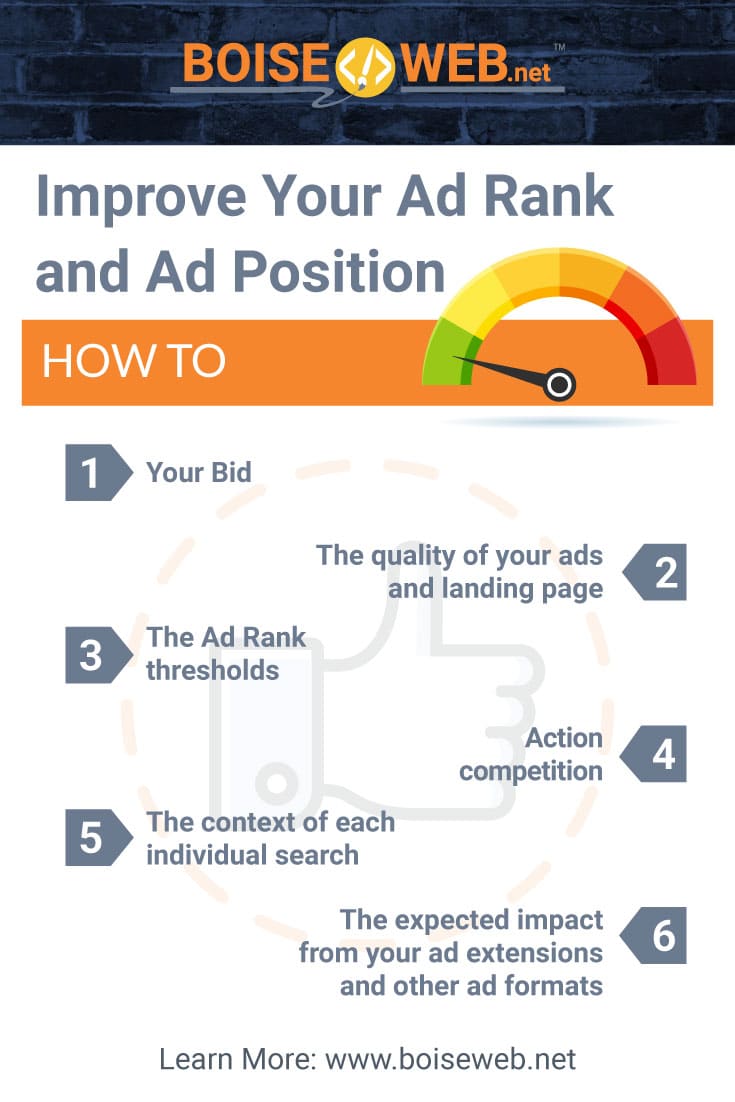It’s no secret that Google uses SEO and quality scores to expertly separate the types of websites customers want to see from all of the other junk that exists on the internet. However, when you’re first starting out it’s easy for your legitimate business to get swept up with all of the “junk” sites. This is where improving your SEO and ensuring your quality score and ad rank are good can really set you up for success and put you ahead of the competition.
How to Improve Your Google Quality Score
1. Review your quality score components
Your Google quality score is made up of three components: expected click through rate, ad relevance, and landing page experience. Naturally, when you are looking to improve this score, you should start with those three areas of your ads to see how they stack up. Each of these components is evaluated with a status of “Below Average”, “Average”, or “Above Average” on Google Ads. However, your quality score itself is ranked on a 1-10 number scale. A rating of “Average” or “Below Average” indicates that you could improve your score on an individual component basis, but you can also look at your quality score as a number for your campaign as a whole.
2. Make your ads and keywords more relevant
Ad relevance shows how relevant your ads are to the keywords they’re targeting. This could mean that your keywords are too broad, or that your ad copy could use some sprucing up. There are several best practices that you can follow when focusing on making your ads more relevant. First, match your ad text more directly to your search terms. This means that when writing your ad copy your headlines should include exact matches of your keywords. It may feel awkward and repetitive to write this way, but it has been proven that including keywords in your ad copy brings in more people clicking on your ads and will also boost your ad relevance and ad ranking, making your ad more prominent and enticing to click on. Secondly, you can look at how broad your ad group keywords are. If one ad group is servicing a very wide variety of keywords, it’s unlikely to be very successful. Try to narrow your keywords down to just one specific topic that you can focus your ads on and then create additional ad groups for similarly related topics that are too broad to group together. Finally, try grouping your keywords into themes. For example, if you were selling rings you could have one ad group focusing on the keyword “engagement rings” and close variants of that keyword, and you could have another ad group focusing on the keyword “wedding bands” and its’ close variants. This final option should typically only be used once the first two practices have been attempted, as it is more than possible for your ad groups to be successful without going into such precise detail to make your ad groups so specific.
3. Try to improve your CTR
The second component of your quality score is your click-through-rate, commonly referred to as CTR. Your CTR historically is used to determine how likely people are to click on your ads. The more likely Google thinks your ads will be clicked on the higher they will be placed. Six ways that Google’s best practices recommend you improve your CTR are as follows:
- Edit your ad text to make a more compelling offer to your target audience
- Make sure the details in your ad text match the intent of your keywords
- Highlight a unique benefit of your product or service above the competition’s
- Experiment with different calls to action to see which one garners the most attention
- Create compelling calls to action with words like “Buy, Sell, Order, Browse, Find, Sign up, Try Now, Get a Quote Today”
- Make your ad text more specific
4. Consider updating your landing pages
- Give people what they’re looking for. If someone searches for “flannel shirts” and clicks your ad for “flannel shirts,” the landing page they go to should feature your flannel inventory.
- Keep messaging consistent from ad to landing page. Make sure the page follows through on the ad’s offer or call to action. Even if you have no control over your site, you can still experiment to find the most useful existing pages.
- Try using conversion rate as a proxy for good landing page experience. It doesn’t impact your landing page status, but it can be a good way for you to measure and optimize.
- Make your website mobile friendly. Ease of navigation is something users value even more on mobile websites. You can use the Mobile-Friendly Test to see how well your landing page works on mobile devices.
- Improve loading speed. The speed at which your page loads can be the difference between someone bouncing or buying.
How to Improve Your Ad Rank and Ad Position
6 Factors of Ad Rank:
-
- Your bid – When you set your bid, you’re telling Google Ads the maximum amount you’re willing to pay for a click on your ad. How much you actually end up paying is often less, and you can change your bid at any time.
- page – Google Ads also looks at how relevant and useful your ads and corresponding landing pages are to the person who will see them. The assessment of the quality of your ad is summarized in your Quality Score, which you can monitor and improve within your Google Ads account.
- The Ad Rank thresholds – To help ensure high quality ads, Google sets minimum thresholds that an ad must achieve in order to be shown
- Action competition – If two ads are competing for the same position and have similar ad ranks, each will have a similar opportunity to win that position. As the gap in ad rank between two ads grows, the higher-ranking ad will be more likely to win but also may pay a higher cost per click for the benefit of the increased certainty of winning
- The context of each individual search – With the ad auction, context matters. When calculating Ad Rank, Google looks at the search terms the person has entered, the person’s location at the time of the search, the type of device they’re using, the time of the search, the nature of the search terms, other ads and search results that show on the page, and other user signals and attributes. All of these factors come together to influence which ads will show for every given search.
- The expected impact from your ad extensions and other ad formats – When you create your ad, you have the option to add additional information to your ad, such as a phone number, or more links to specific pages on your site. These are called ad extensions. Google Ads estimates how extensions and other ad formats you use will impact your ad’s performance and that factor is also added in to mix of determining your ad rank.
Additional SEO Tips to Grow Your Business
- Use an on-page SEO checklist – An on-page SEO checklist is a list of things that you can do to your page to best optimize it for SEO purposes. Below is a 33 point checklist that you can use to check your own webpages. 33-Point On-Page SEO Checklist
- Write more inclusively -Another huge aspect of SEO in inclusivity and how accessible your website is. Making your site accessible isn’t necessarily difficult in any way, but it is an extra step that most people (especially those of us creating the sites that don’t need inclusive access) forget about. Below is an article listing out 11 steps that you can take to make your website more inclusive. Inclusive Design: 11 Ways to Make Your Website More Accessible
Commonly Asked Questions
How do I know if my landing pages are performing well?
If your campaigns are performing well in every other aspect: keywords and ads have a high CTR, your spend is low, but you’re still not getting conversions, it could be a sign that your landing pages are not performing well. To figure out if this is truly the case go back to your research. Look up your top competitors’ websites and see how their landing pages compare to your own. Based on this research, learn what your landing pages could improve upon and make changes to see if it then improves your conversions.
What should my budget be?
While it greatly varies between different business and different campaigns, I tend to set most of my campaigns at a starting budget of $5. I watch my new campaigns closely and if they perform well, I might raise the budget. However, if they do not perform well, I make sure to quickly fix the problem or lower the budget if the campaign is hurting the overall account.
How do I know if my campaign is performing well?
While what is considered “good performance” greatly varies from business to business, there are a few things to look for when you’re first getting started. A CTR (click through rate) of 2% or higher is considered a good interaction rate with your website, and anything below a 1% is very bad. When looking at conversions, the best tool to use is the Conversion Value/Cost. This calculates your ROAS (return on ad investment) and a ROAS higher than 4 is generally considered good.
Related Articles:
Everything You Need to Know About Google Ad Keywords
The Different Types of Google Ads and How to Use Them
The Different Google Ad Campaign Goals and When to Use Each One
Google Ad Bidding Strategies and When to Use Each One
The Different Google Ad Extensions and How to Use Them
How to Set up a Search Campaign in Google Ads



